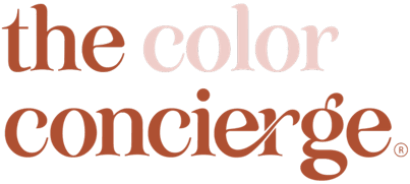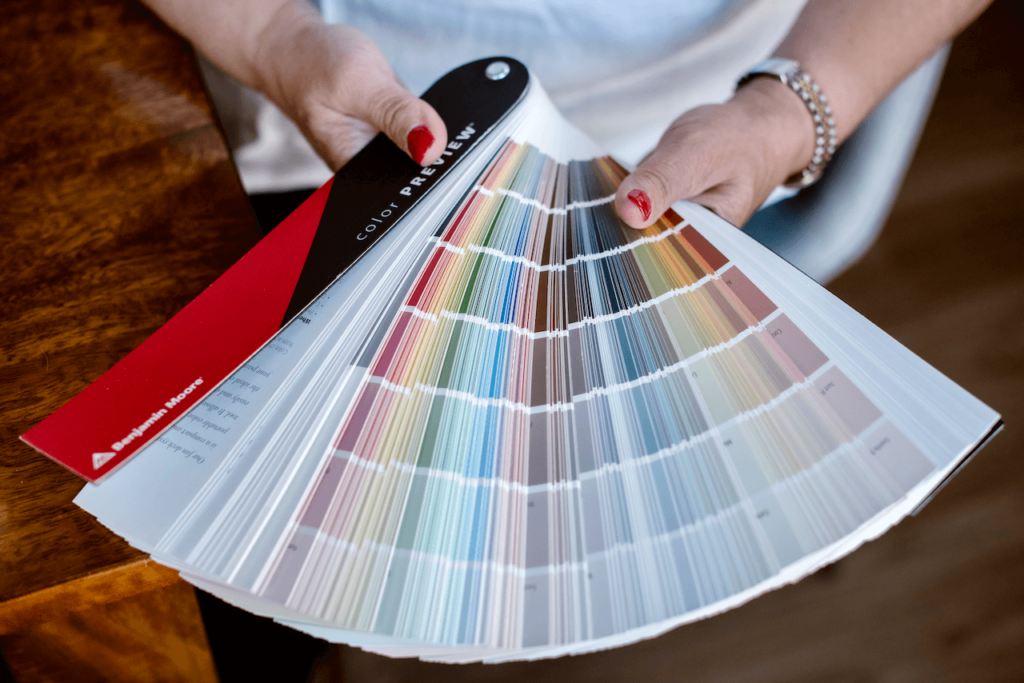Learning how to choose white paint colors is no easy task. If you’ve walked into your local paint store and browsed all the white paint samples, then you know this firsthand.

There are so many different types of white colors from all the top paint brands, and many with names that don’t accurately describe what they look like on the wall.
So how are you supposed to find the white paint color that’s right for your next project? Thankfully, it is possible to make the process less overwhelming. You can work with a paint color consultant like me and the rest of the team here at The Color Concierge, who can help you find and test the best white paint colors for your home.
Want to DIY your choice? Then you’re in the right place. In today’s post, we’re sharing all our best color consultant tips for choosing white paint colors. Keep reading for our full breakdown and simple strategies.
*This post contains affiliate links for products I use and love. If you click on some links and make a purchase, I will get a small commission at no cost to you. This helps pay for the costs of the blog, so I can continue to offer great content to our readers.
About The Color Concierge
Our Colorado-based paint color consultants make finding the right paint colors for your home easy. Whether you’re painting the exterior or interior of your home, our simple yet effective process lets us get your paint color right the first time. We’ve helped thousands of homeowners transform their homes into a space they love. Learn more about ONLINE COLOR CONSULTATIONS today.
Our Paint Color Consulting Methodology
Before we discuss choosing white paint colors for your home, I’d like to share a bit more about the origins of our methodology. We utilize color expert Maria Killam’s color consulting methods with our clients, including guidelines for selecting white paint colors, which we’ll share today.
Both myself, Michelle Marceny, and my colleague Maddie Camilli, are True Color Experts and have taken Maria’s classes. We use her methods for color specification every day in our practice. It has become part of our DNA as paint color consultants. We truly live and breathe it.
And now we’re sharing these methods with you. By the time you reach the end of this post, you’ll have all the knowledge you need to select the perfect white paint color for your next project.
Want even more details? Check out Maria’s book: White Is Complicated: A Decorator’s Guide to Choosing the Right White. You can also get a bundle of Maria’s e-books with a special discount exclusively for Color Concierge blog readers! Use code colorbundle20 to get 20% off either the e-book bundle or the e-book+neutral color wheel bundle.
How to Use These Guidelines
The tips for choosing white paint colors we’ll be sharing in today’s post can be used for just about any situation in which you need a white hue, including:
- Picking white trim and ceiling colors (Article)
- Selecting the perfect wall white to pair with your trim and ceilings.
- Picking a white cabinet color (Article) to pair with granite, stone or countertops
- Comparing tile with wall paint colors
- Comparing different tiles with each other
- Anywhere you need two types of whites, not just paint colors (such as art, furniture, carpeting, etc)
Sample White Paint Colors
We always recommend that you test paint colors on your home because lighting can change a color completely, both with interiors as well as exteriors. This is especially true for white paint colors, which can be heavily influenced by the colors around them.
In the old days, this meant we painted a large poster board with sample pots and a huge mess.
Now we have a better way to test paint, with Samplize Peel-and-Stick samples!
- Samples pre-painted with 2 coats of real paint from the manufacturer.
- Large 9” x 14” samples to see the color better in the lighting.
- Delivered overnight
- Colors are accurate
- Less expensive than painting a large poster board with sample pots
- No mess, and no toxic paint to dispose of
I use these in my color consulting practice for exact results. Discover Samplize peel-and-stick paint samples:
Understanding the Types of White Paint Colors
The first step to choosing a white hue is to understand the types of white paint colors and how they work (or don’t work) together. There are four main types of white paint colors:
Blue-Whites
These are exactly what they sound like: white paint colors with blue undertones. These are cool hues and in certain light can even look a bit blue in place.
We usually pick blue whites for trim and ceilings if your interior has very crisp and “fresh” finishes, such as bright quartz, clean colored tiles, or cool gray decor. Avoid using if you have alot of exposed wood trim, beams, or cabinets, granite, or other earthy finishes. Many builders in the US automatically specify this type of trim and ceilings in homes; they stock SW Extra White by the truckload. However, it doesn’t always mean it’s the perfect white for your house.
Some popular blue-white paint colors include:
- Sherwin-Williams Ceiling Bright White
- Sherwin-Williams Extra White (Article)
- Benjamin Moore Decorator’s White (Article)
- Benjamin Moore Pure White
The house shown below has SW Extra White painted on the ceilings, walls, and trim. This was a lovely tract home that the builder delivered with this white paint color. Fortunately, the Extra White paired well with their crisp quartz and clean-colored tiles. The homeowners brought me in to add some color with accent walls and bedroom colors.
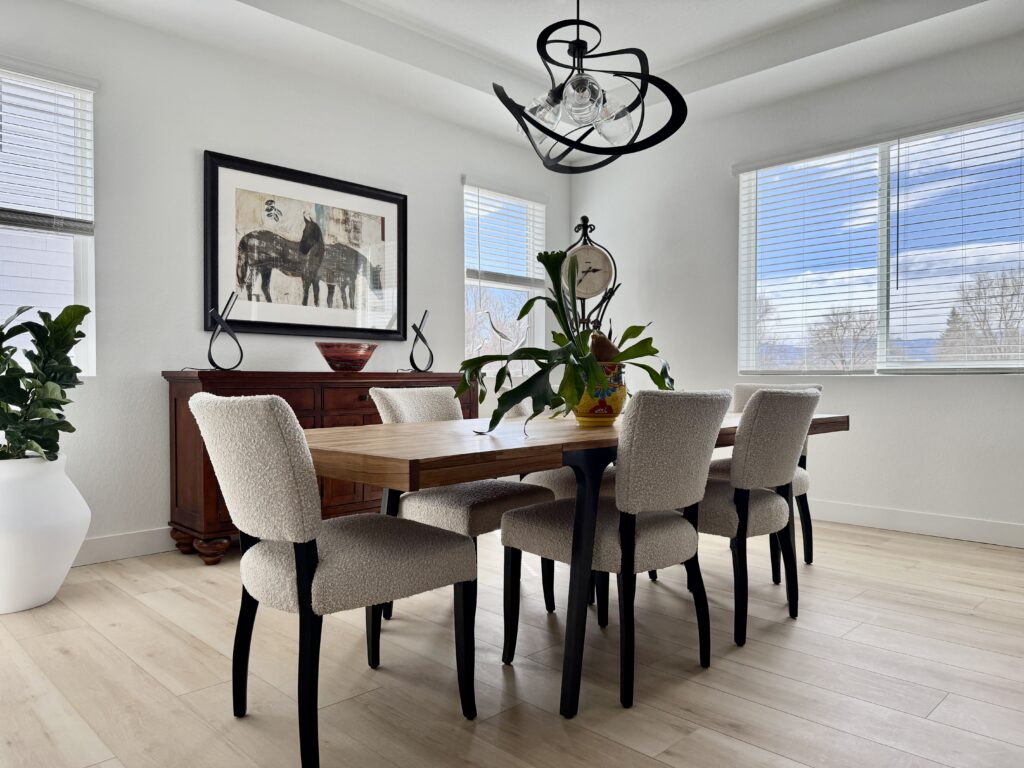
Clean Whites
Clean whites are very neutral whites. They are not overly cool or overly warm. These are the most versatile white paint colors because they coordinate well with many types of paint colors (including other whites).
We usually pick clean whites if your interior has very crisp and “fresh” finishes, such as bright quartz, clean colored tiles, or cool gray decor. Avoid using it if you have a lot of exposed wood trim, beams, or cabinets, granite, or other earthy finishes. Use clean whites as trim and ceiling colors with cooler and cleaner paint colors.
Some popular clean white paint colors include:
- Sherwin-Williams High Reflective White
- Sherwin-Williams White Snow
- Benjamin Moore Chantilly Lace (Article)
- Benjamin Moore Oxford White (Article)

Off-White
Off-white paint colors are warmer whites and typically have yellow or green undertones. These are often more muted than clean white paint colors, which tend to be more crisp. They also typically (but not always) have lower LRVs than clean whites, which means they are darker in place.
Pick off-whites for trim, wall, and ceiling colors if your finishes are more muted or earthy. For example, if you have Calacatta Marble, quartzite, earthy tile, or lots of wood. We like to use these types of colors with darker wall colors.
Some popular off-white paint colors include:
- Sherwin-Williams Greek Villa (Article)
- Sherwin-Williams Alabaster (Article)
- Benjamin Moore White Dove (Article)
- Benjamin Moore Simply White (Article)
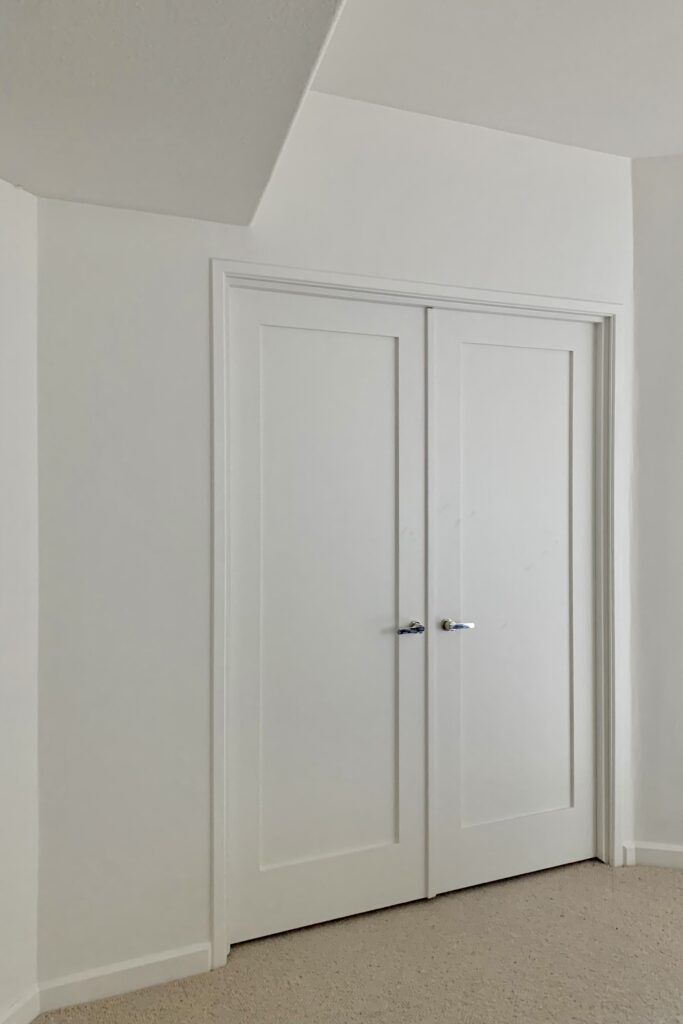
Creams
Creams are the final category of white paint colors. These are the warmest and often the darkest of the white paint colors. Creams often have yellow undertones but can also have peachy or subtly green undertones. We don’t use these that often for interiors, so below I show BM Seashell outside.
Pick creamy whites for trim, walls, and ceilings if your finishes are more muted or earthy. For example, if you have Calacatta Marble, quartzite, travertine, slate, earthy tile, or lots of wood. Pay attention to the undertones. If your finishes have pink in them, avoid pairing them with a cream that contains a lot of yellow. We like to use these types of colors with darker wall colors. Creamier colors, such as Swiss Coffee, look fantastic with Taj Mahal quartz, for example.
Some popular cream paint colors include:
- Sherwin-Williams Creamy
- Sherwin-Williams Shell White
- Benjamin Moore Marscapone
- Benjamin Moore Seashell
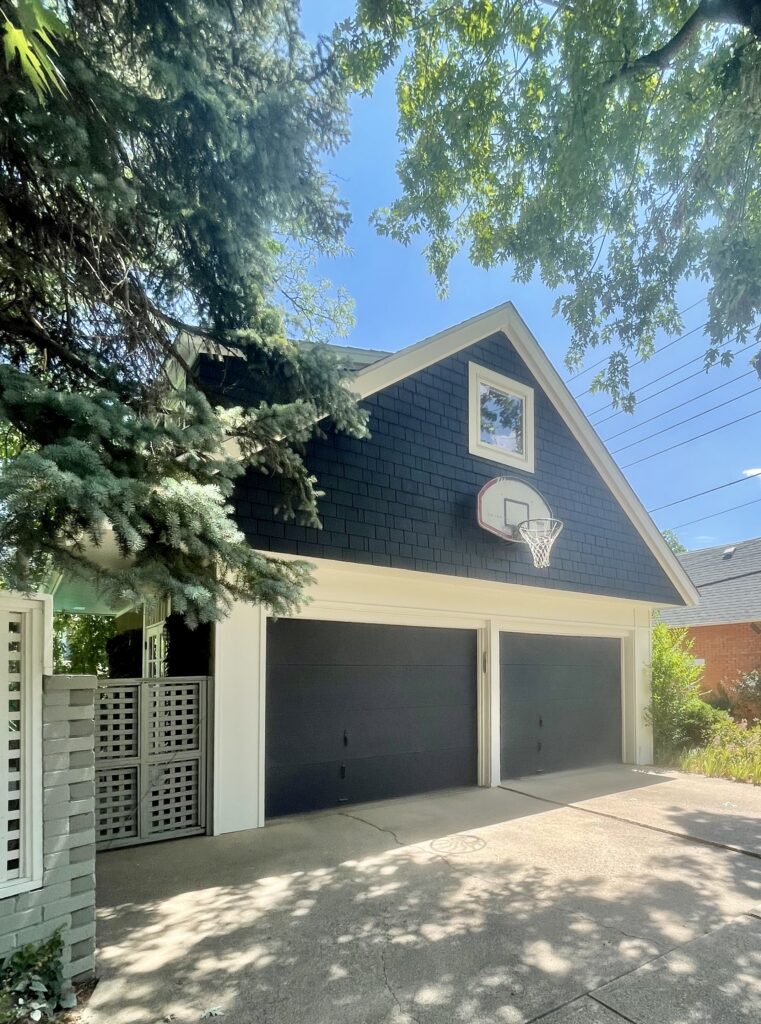
Combining White Paint Colors with Other Whites
Now that you know the different types of white paint colors, it’s time to explore how these white hues go together, and combinations you should avoid, and when to use them. This is especially important when you need to choose two white paint colors, such as for walls and trim, or walls and cabinets.
The key is to picture the types of paint colors in a line, starting with the coolest (blue-whites) and ending with the warmest (creams), as shown in the graphic of Sherwin-Williams paint colors below.

Each color group can only successfully be paired with the color group or groups adjacent to it. So blue-whites can pair with clean whites, but not with off-whites or creams. Creams can pair with off-whites but not blue-whites or clean whites. This is also shown in the graphic of Benjamin Moore paint colors below.

The most flexible white paint colors out there are clean whites and off-whites because you can pair them with two different types of white hues:
- Clean whites can be paired with off-whites and blue whites.
- Off-whites can be paired with clean whites and creams.
You’ll see in the graphic below that trying to pair colors outside of these combinations can look discordant. The colors are just too far apart.
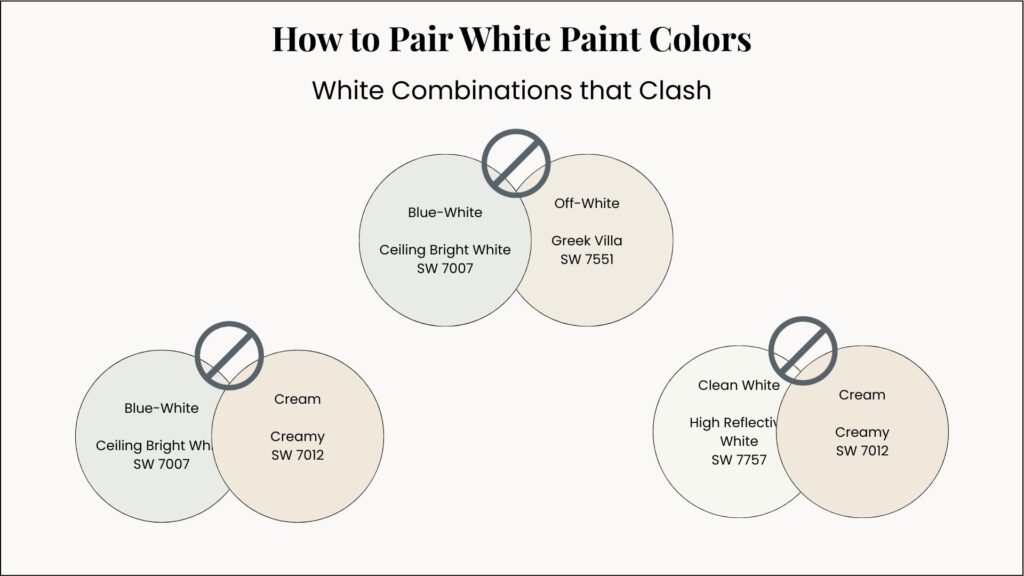
This is exactly why Sherwin-Williams Extra White (Article) and BM Decorator’s White can be so challenging to work with. SW Extra White has most commonly been selected by builders in the last few decades, but it’s actually a blue-white hue that can be very limiting.
I like to recommend clean whites like SW White Snow or BM Chantilly Lace, OR off-whites like BM White Dove or SW Pure White when I can, but it’s not always possible for clients to repaint all the trim in their home. In these cases, knowing the type of white you’re working with can help ensure you choose wall colors that won’t look discordant.
Paint Color Consultant Tips for Choosing White Paint Colors
Now that you have a thorough understanding of the different types of white paint colors and how they work together, it’s time for our top tips to choose the specific hue that is right for your project.
Use these steps to find your perfect white:
Start with the cleanest white in your selected brand to compare with other whites
Color is all about comparison. You often can’t truly see a white hue’s undertones until it is compared with another color. So the best place to start is by finding the cleanest whites in the paint brand you plan to use and comparing cooler and warmer white colors from there. You won’t necessarily end up with this color, but it’s a great baseline to compare with blue-whites, off-whites, and creamy whites.
For Benjamin Moore, the cleanest white is Chantilly Lace. For Sherwin-Williams, it’s White Snow or High Reflective White. Invest in several Samplize samples of the paint colors and compare them to each other in natural light. Also, compare with the finishes in your home, such as countertops, backsplashes, and other tile, to see which looks best.
Choose your trim paint.
When selecting the trim for your house, opt for blue-whites and clean whites with crisp, clean finishes, such as Carrara marble, black metals, white quartz, and other clean tiles, paired with cleaner paint colors. Select off-whites and creamy whites for earthy finishes, such as granite, wood trim, bronze accents, and cabinets, as well as quartzite, and pair them with earthier, more muted paint colors. The earthier the finish, the creamier you should go.
Ideally, choose a lighter white (with a higher LRV) for your trim and ceilings that matches the walls. Be sure to pay attention to the type of white paint color you use for your trim.
While many homeowners have a blue-white like Extra White as trim and ceiling colors, it can be limiting. Using the clean white identified above is often a more flexible option. Off-whites and creams are more appropriate if you have alot of earthy finishes in your home. Off-white is more flexible than cream as a trim color. Ideally, you can pick the same white for the trim and ceiling.
You can also use the same white for all your surfaces, shifting sheens for ceilings (flat), walls (matte or eggshell), and base molding (satin). If budget is an issue, and you are using the same white color for all walls, you can also save money by using a matte sheen for ceilings and walls. That way, you don’t have to cut in the ceilings.
If you have a lot of black in your house with white finishes, then use a blue-white or clean white. If you have alot of bronze, brown, or wood in your house, then pick an off-white or creamy white.
Consider your finishes.
We often think of white as a color that goes with everything. But when it comes to white paint colors, this isn’t actually the case.
Remember: blue-whites and creams are very limiting and look discordant with off-whites and creamy whites. Similarly, the undertones of a white paint color can look discordant with finishes that have different undertones.
When choosing white paint, consider the hard finishes that will be in the same space, such as flooring, tile, countertops, and backsplashes. If your hard finishes are earthy, pick a warmer white. If your finishes are cool, like Carrara marble, then I’d lean toward a clean white, such as BM Chantilly Lace or SW White Snow.
LRV can be deceptive.
A higher LRV means a color is lighter, while a lower LRV makes it appear deeper and darker. As you go from blue-whites to creams, LRVs can really vary. Just because a white is creamy, doesn’t mean it’s dark.
For example, SW White Flour (warmer off-white) has an LRV of 86, and so does Extra White (blue-white). Just because a white is creamier doesn’t mean it’s darker. It just has a stronger undertone and more pigment.
The LRV of white paint colors is another key factor to keep in mind. LRV stands for Light Reflectance Value. It’s a number from 0 to 100 that shows how much light a paint color reflects. Zero is pure black (absorbs all light) and 100 is pure white (reflects all light).
Consider your lighting.
Read our full guide to the best white paint colors for dark rooms.
Choosing white paint colors for dark rooms can be especially tricky (Article). While many homeowners think they should choose a bright white (such as a clean white or blue-white) for a space with low light, this can actually look dingy and gray in the corners. Off-whites with a bit of yellow, on the other hand, such as BM White Dove, BM Simply White, or SW Snowfall White, can really shine in a dark room.
It’s also important to pay attention to the type of lighting in your space when choosing a white paint color. If you have cool Northern light, for example, a blue-white could actually look blue on the wall. On the other hand, a cream color in a room with very warm light could look yellow.
Don’t forget to test.
Of course, you can never choose a white paint color without thorough testing. We recommend using Samplize peel-and-stick paint samples for ease of use. Narrow down your options to a few colors and then test them in the spaces where they will be used. Be sure to compare them to your trim, flooring, furniture and other finishes and test them throughout the day so you can see how they look as the light shifts.
Read our complete guide to testing paint colors like a pro.
Other Resources for Choosing White Paint Colors
Want even more help for choosing the right white paint color? We’ve written extensively about our favorite white hues. You can use these resources to help you narrow down your options.
- Best White Paint Colors for Dark Rooms
- Best White Paint Colors for Kitchen Cabinets
- Best Sherwin-Williams White Paint Colors
- Best Benjamin Moore White Paint Colors
- Best White Trim Colors from Sherwin-Williams
- Best White Trim Colors from Benjamin Moore
- Best Paint Colors for North-Facing Rooms
- Best Paint Colors for South-Facing Rooms
Key Learning Points
Choosing the right white paint color isn’t simple, but it is absolutely possible! The key is having a strong understanding of white colors and how they work with other hues.
- There are four main types of white paint colors: blue-whites, clean whites, off-whites, and creams.
- Clean whites and off-whites are the most flexible. Blue-whites and creams are more limiting thanks to their undertones.
- Blue-whites and clean whites pair best with clean, crisp finishes, such as Carrara marble and white quartz, as well as bright, clean tile.
- Off-whites and creamy whites look best with warm finishes such as Taj Majal Quartzite or granite. The warmer and earthier the finish, the creamier you should go.
- Pay attention to your natural lighting and hard finishes, as well as the undertones when choosing a white paint.
Remember: NEVER, EVER use paint matches from a different brand than the one specified. Results are poor and there are no standards for the sheens. Even though your painter may truly believe it can be done, don’t do it. See results from paint matching here.
No matter what, always test your paint colors. It’s a standard best practice. Whenever I test my paint colors, they are perfect, and when I don’t test they turn out wrong. Learn how to test your paint colors here.
Online Color Consulting
Still need help picking the best paint colors? Discover our Online Color Consulting Package.

About the Author
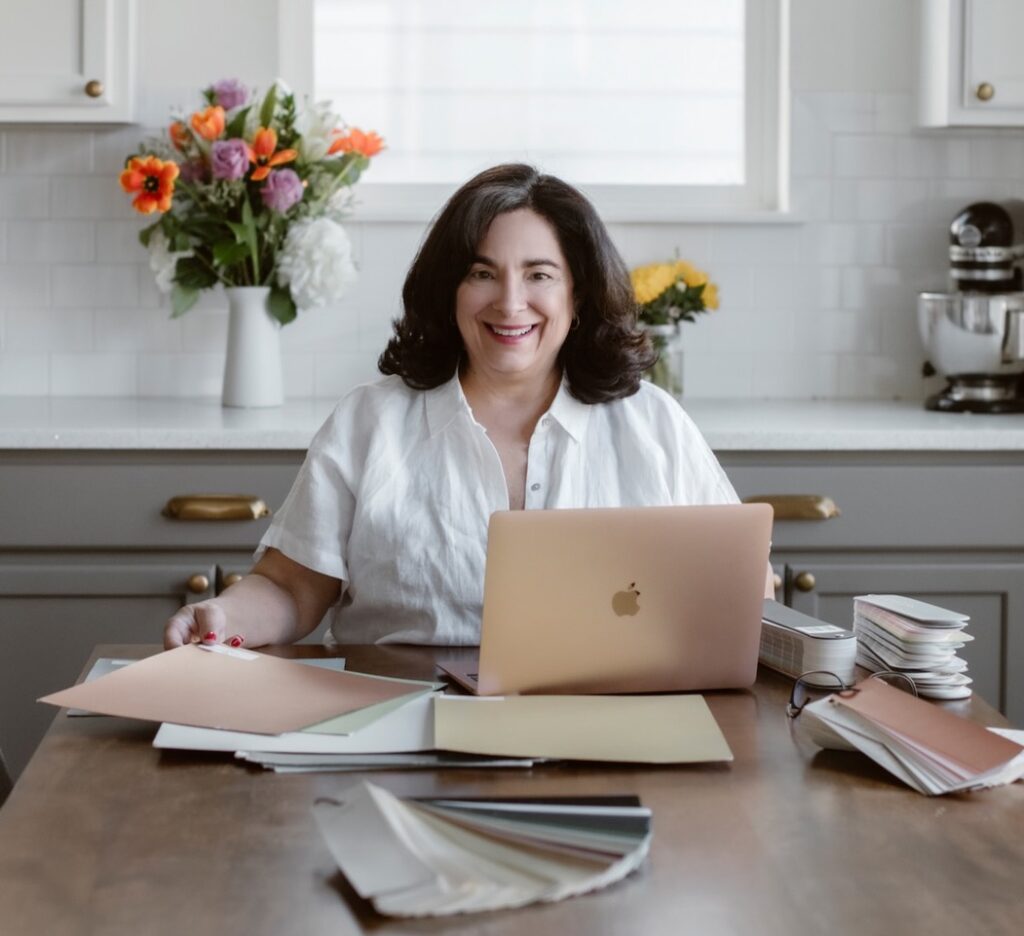
Hi, I’m Michelle Marceny, founder, owner, and Principal Color Designer at The Color Concierge. I believe a fresh coat of paint can completely transform a space. The Color Concierge was born out of my drive to help clients fall back in love with their homes. My clients trust me to help them find the perfect paint color for their home – whether it’s a whole-house paint color scheme or ideas for a single room.
Since The Color Concierge was founded in 2017, we have completed over 3000 color consultations, both online and in-person. I am a Certified Color Expert with 7 years of experience creating interior and exterior color palettes throughout North America.
We love your comments! Please note that the blog is meant as general advice, and it is not possible to give out specific answers to your paint questions. If you want more specific advice, please purchase a color consultation. Thank you for your understanding.
